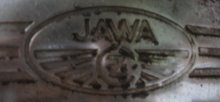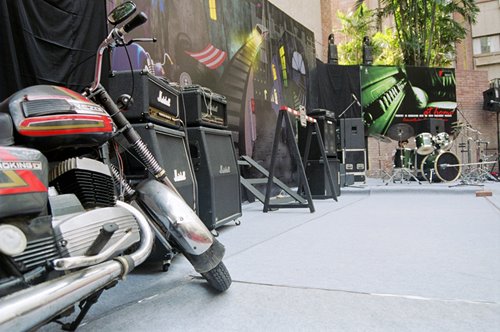

Yezdi, Jawa, CZ, Two-stroke Motorcycles, Zen & the art of Perpetual Maintenance, Motorcycle Diaries (the genre!), Restorations, Rustorations, Mods, Stock, Custom, Vintage, Classic, Stable, Fleet, and any heavy metal anachronistic piece of noble machinery defined in mythological lore of increasing association. Beware poseurs, boulevard cruisers and mindless free service addicts. This blog will bore you.
 comes a time...
comes a time... I never try and explain how points should be set.
I never try and explain how points should be set.  Okeh peeps, dis is where you check your chain tension. Reach thru dem spokes and slide the 'patti' holding the round disc in place. Choose a finger you want to dirty and push up/down on the chain to guage tension.
Okeh peeps, dis is where you check your chain tension. Reach thru dem spokes and slide the 'patti' holding the round disc in place. Choose a finger you want to dirty and push up/down on the chain to guage tension. First, remove the rear axle as shown.

Modify a yezdi and you must be idle, rich or an impromptu engineer. Who cares, obviously you have yet to experience the thrill of a Roadking.
Which brings me to the next law...
9. Modify a jawa (!) and me and my mates will kill you. Period. We appreciate the jawa for what it is and we dont screw around with heritage bikes.
10. Change your road attitude. On an old bike like a Yezdi, you are sure to be noticed. Some will comment, only the real dudes will stop and politely engage you in a conversation. Stick your chest out, lounge on the bike at red lights and look around kingly-like. Try doing it on a modern 100-220cc motorcycle stepped-seat and you are going to wonder why your arse is sticking out in that undignified manner. You got a yezdi and she fills up your senses like Annie's s(hl)ong.
Stop cursing everybody on the road and smile instead. Hey! your bike is different, so why have the same cruddy attitude as everybody!?!
Face it, you are in a different world on a Y-bike.


 Let's start
Let's start 
 Let's start you on a journey into your own inner space. Since time has no meaning to forever bikes, let's go to the source of the magic:
Let's start you on a journey into your own inner space. Since time has no meaning to forever bikes, let's go to the source of the magic:  Move on to the rear foot peg on the same side, and remove the bolt holding the side cowling panel to the rear foot peg support rod. You might not need to remove both nuts at the rear foot peg, as the side cowling is just attached to one of the two bolts. Move up to the point where the tank ends, remove the long bolt that holds the rear of the tank and the side cowling to the frame.
Move on to the rear foot peg on the same side, and remove the bolt holding the side cowling panel to the rear foot peg support rod. You might not need to remove both nuts at the rear foot peg, as the side cowling is just attached to one of the two bolts. Move up to the point where the tank ends, remove the long bolt that holds the rear of the tank and the side cowling to the frame. Put the bike into neutral and turn the wheel, watching the chain for the link which has the chain lock on it. It's actually quite simple, just use a large screwdriver's flat head to push the 'U' shaped clip/lock on the side of the link facing you. That is the way it is always assembled, with the chain lock clip outwards, and that is exactly how you will replace it later. Removing the clip enables the flat figure-of-eight shaped side piece of the link to come off the link. Just remove the other figure-of-eight shaped piece with the two straight bits sticking out of it from the other side of the chain, and it's in your hand.
Put the bike into neutral and turn the wheel, watching the chain for the link which has the chain lock on it. It's actually quite simple, just use a large screwdriver's flat head to push the 'U' shaped clip/lock on the side of the link facing you. That is the way it is always assembled, with the chain lock clip outwards, and that is exactly how you will replace it later. Removing the clip enables the flat figure-of-eight shaped side piece of the link to come off the link. Just remove the other figure-of-eight shaped piece with the two straight bits sticking out of it from the other side of the chain, and it's in your hand.  Step back and ask yourself if all you need to do next is remove the main (sometimes called 'foundation') bolts that actually hold the engine in place. Proceed towards the engine mounting bolts with two spanners or one spanner and a ratchet, or whatever, You still have to anchor one end of the bolt while opening the other. I, personally have replaced the nuts here with lock nuts. Those are the ones which have a nylon collar or ring inset into the threads at one end. The nylon holds on to the bolt threads for dear life.
Step back and ask yourself if all you need to do next is remove the main (sometimes called 'foundation') bolts that actually hold the engine in place. Proceed towards the engine mounting bolts with two spanners or one spanner and a ratchet, or whatever, You still have to anchor one end of the bolt while opening the other. I, personally have replaced the nuts here with lock nuts. Those are the ones which have a nylon collar or ring inset into the threads at one end. The nylon holds on to the bolt threads for dear life. 













